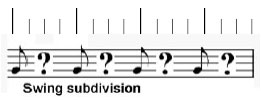« Best of JM: Compose yourself. Story Arcs |
Main
| Artist phrasing »
 September 19, 2013 | Don't mean a thing. If it ain't... September 19, 2013 | Don't mean a thing. If it ain't...
The perpetual question, "How can I swing?"
The short answer has always been a subjective and not entirely complete, "listen, listen, listen," but we'd like to suggest there are also concrete practical principles to consider. Yes, you want to listen to great music. Immerse yourself in the jazz giants, but while you're doing this, consider three aspects of rhythm you'll want to copy and assimilate into your playing, shuffle, articulation, and drag.
Shuffle. In an early (June 2005) MandolinSessions article outlined how we divide rhythms, and if you have never read this, it's worth the time. There is also an accompanying exercise to help you get your groove on, go back: "On the Up and Up: Jazz articulations." We talked about division and subdivision, divining a beat into halves (duple) and thirds (triple), and further subdividing, complete with a visual map of note placement:

Our conclusion was that in variations of true swing, you would find the divided beats in different degrees of shuffle. A good demonstration of this is to place your hands together in "prayer" position. Now rub the palms in motion, counting 1 & 2 & 1 & 2&, etc. (count out loud, too). Now do the same as if you were counting triplets 1& duh 2 & duh 1& duh 2 & duh (keep the same tempo) alternating on the 1st and 3rd division). Go back and divide in half again, and after you're set, move into the triple. Alternate between the duple and the triple. As you get comfortable doing this, try variances of something in between the two feels. Now go listen to your favorite swing music and try to feel which of the two, duple or triple the music is. What you'll find at various tempos, the subdivision is somewhere in between. If you're rubbing your palms in even thirds, it sounds terribly sterile; if your dividing in half, even worse.

When drum machines came out in the mid 1980's, many models included a "shuffle" slider or knob that would allow you to tweak the feel somewhere in middle of duple and triple. It's the dirty little secret of "Hip Hop" studio production (such an oxymoron...), dialing into that magic feel, and sustaining it metrically through the song. It didn't sound "machine-like" because the brain struggles to comprehend what the division is.
Articulations. Mandolinists particularly struggle with a good swing sound for two reasons, 1.) the limited sustain of our plectrum treble range and 2.) the fact that every articulation is struck hard with a pick. Mandolin is not like a sax that can "Fooh Fooh" or "Thudt Thudt," tonguing into a note to varying degrees. We have one articulation, and it's either on or off. This means we work a little harder than our wind brethren to communicate swing. In addition to making sure our phrases are linear and well sustained, the best thing we can do is develop a rich upstroke. The MandolinSessions article mentioned prior goes into this in more detail, even offering an exercise to make yourself conscious of the need for a healthy upstroke. Think Frank (Sinatra). Doo BEE Doo BEE Doo...
Drag. Note, this is different than "shuffle." Sure you drag the upbeats to a certain point, but you can also drag an entire section of notes. Leave the meter and breathe some human-ness into your improvisation.
Say you have a triplet pattern; try delaying each of the notes ever so slightly. Real swing musicians don't play in the box all the time. You need a good sense of time always, but that's internal (and held up by a good rhythm section or accompanying instrument). Don't lose track of where the beat is, but play around it.
This swing stuff is so subjective, but you can still listen and develop tricks that you'll inject into your playing and improvising.
Further:
Swing Hard. Pick Well.
It's a drag...
"On the Up and Up: Jazz articulations.
Hipsters, flipsters, and finger-poppin' daddies
Posted by Ted at September 19, 2013 12:15 PM

Disclaimer: In the 'Information Age' of the 21st Century,
any fool with a computer, a modem, and an idea can
become a self-professed 'expert." This site does not
come equipped with 'discernment.'
|



